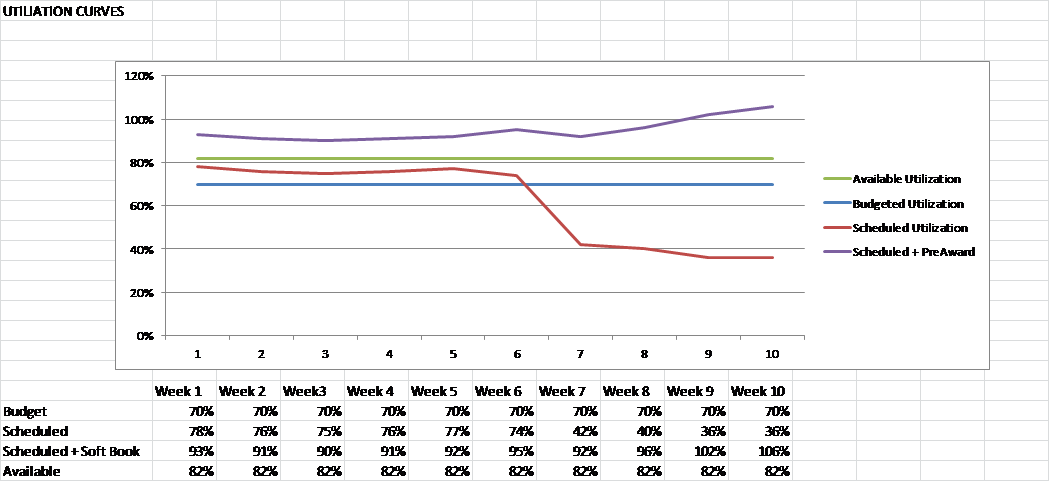Full Sail Partners Blog
What is Forecasting and How Can it Benefit Professional Services Firms
 What is forecasting? Forecasting is a tool that many professional services firms use to help management make decisions based on past and current data trends.
What is forecasting? Forecasting is a tool that many professional services firms use to help management make decisions based on past and current data trends.
There are two types of forecasting we will focus on in this article:
- Utilization forecasting
- Cash flow forecasting
For professional services firms, forecasting starts with the analysis of the work that is yet to be performed and equating that to overall firm revenue. The revenue then becomes the basis for the accountant to project cash flows coming in, considering average day’s receivables, to drive what cash is available versus the cash required to cover current expenses.
Without these forecasts, it makes it much more difficult for management to schedule, staff, plan or perform the work in production that is necessary without them sitting up in bed at night on a regular basis.
So let’s break the process down into steps and then focus on the key benefits of what is forecasting.
- To properly track utilizations, it is important to establish two budgeted figures, target utilization and available utilization. Both should be established for every staff person and documented by employee in your system.
Definitions:
- Target Utilization is a function of the targeted billable hours over the standard hours in the work week.
- Available Utilization is a function of all available hours minus just the benefit hours.
One engineering firm we are working with used to post the labor utilization “curves” on their message board in their lunch room and it was measured against budgeted utilization for the year as a constant. This singular graph showed what the firm was projecting for scheduled utilization against target and available which kept staff cognizant of both the need to schedule fully. The graph also served as a tool for staff to promote billable hours against project deadlines.

From this data, management was able to see the most important single factor for the firm, how far out they were scheduled, and if they needed to adjust staff or move project timelines to increase project throughput. Since labor costs against labor revenue is the single most influential impact on a firm’s bottom line, forecasting in this way had this firm’s management sleeping better, while it also empowered the firm’s staff to keep an eye on utilization.
Since this level of tracking was in place at this particular firm, it also allowed their senior financial person to produce informative forecasts of revenue, which in turn, promoted the morale of everyone in the firm.
To note, when the firm had many proposals out with the results tracking per the graph above, and the firm had the ability to look at un-scheduled but awarded professional service hours as well, they knew when staffing could not meet the demand of the impending work and were able to stage clients expectation with delivery dates or let HR know that hiring was needed on the horizon.
So, is your firm enabling forecasting to better win work and deploy resources? If not, after reading this blog do you recognize the importance of implementing forecasting at your firm? I would forecast that the answer is “yes”!
Subscribe Here!
Latest Posts
Posts By Category
- Professional Services (232)
- Technology Solutions (155)
- Deltek Vision (120)
- Deltek Vantagepoint (114)
- Building Business (112)
- Accounting (100)
- Project Management (94)
- CRM (73)
- Press Release (61)
- ERP (53)
- HR (53)
- Marketing (51)
- Client Relationships (48)
- Professional Services Firms (42)
- Deltek Clarity Report (27)
- Finance (20)
- Support (20)
- A&E Firms (19)
- Business Intelligence (19)
- Employees (18)
- Project Based Firms (18)
- Cloud (17)
- Deltek Talent (16)
- Video (16)
- Mobile (15)
- Communication (9)
- Deltek Insight (9)
- Mergers and Acquisitions (9)
- Data Visualization (8)
- Project Information Management (PIM) (8)
- Case Study (6)
- Executives (6)
- Driving Growth (4)
- Information Technology (4)
- business development (4)
- Human Capital Management (3)
- Resource Management (3)
- THOUGHT LEADERSHIP (3)
- human resources (3)
- Artificial intelligence (AI) (2)
- Connect Add-In (2)
- Contract Management (2)
- Outsourced HR (2)
- Project Con (2)
- Proposal (2)
- Deltek + ComputerEase (1)
- Deltek Dela (1)
- Deltek ProjectCon (1)
- Outsourced Accounting (1)
- ProjectCon (1)
- SEO (1)
- password security (1)
Posts by Author
- Amanda McClain (3)
- Amanda Roussel (18)
- Amy Balassone (9)
- Aria Bounds (1)
- Bryce Crosby (1)
- Cate Phillips (9)
- Chris Simei (2)
- Cynthia Fuoco (1)
- Dale Busbey (6)
- Erin Haver (1)
- Evan Creech-Pritchett (24)
- Full Sail Partners (104)
- Gina Stamper (2)
- Heath Harris (4)
- Jake Lucas (2)
- Jeff Robers (1)
- Jennifer Renfroe (64)
- Jennifer Stevland (1)
- Jennifer Wilson (2)
- Jenny Labranche (4)
- Joel Slater (8)
- Kelly Duquette (2)
- Kevin Hebblethwaite (8)
- Kim Stamps (2)
- Lee Frederiksen (1)
- Lindsay Diven (40)
- Lisa Ahearn (5)
- Matt McCauley (4)
- Michael Kessler, PMP (17)
- Nia Collins (1)
- Nicole Temple (3)
- Peter Nuffer (5)
- Rana Blair (20)
- Rhiannon Schaumburg (3)
- Rick Childs (7)
- Ryan Felkel (85)
- Ryan Suydam (10)
- Sarah Gonnella (67)
- Scott Gailhouse (20)
- Scott Seal (12)
- Sean Keller (1)
- Sparsha Muppidi (1)
- Stephany Socha (1)
- Tasia Grant, PHR (16)
- Terri Agnew, CPA (9)
- Theresa Depew (8)
- Timothy Burns (5)
- Tom Vandervort (1)
- Wendy Gustafson (17)
- Wes Renfroe (15)
- Wesley Witsken (4)


